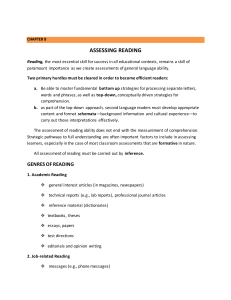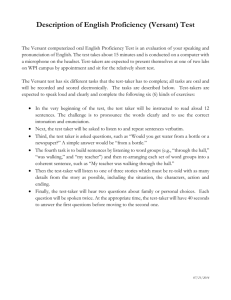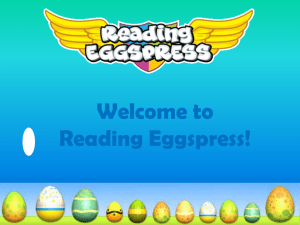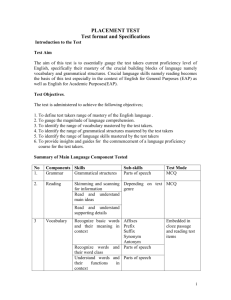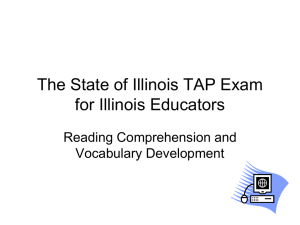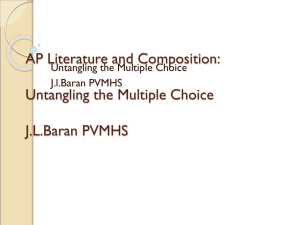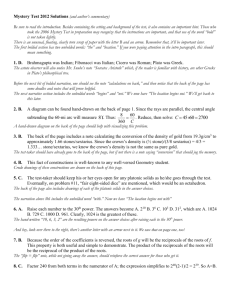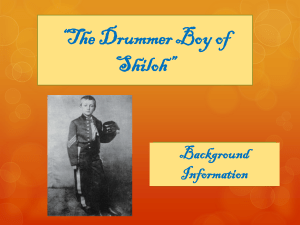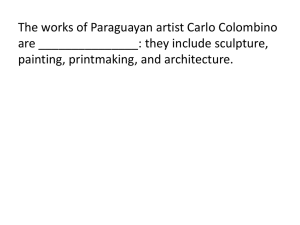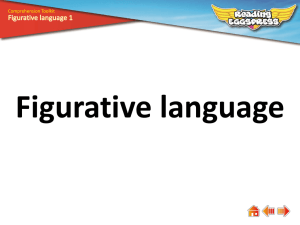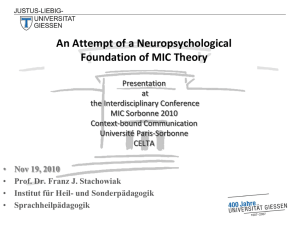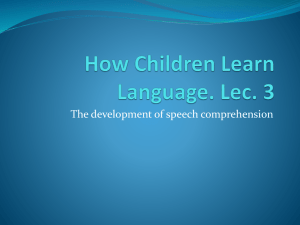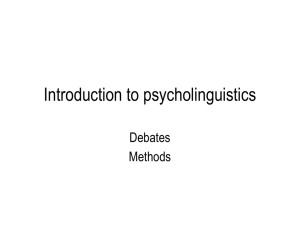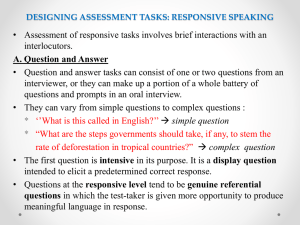Language Assessment
advertisement
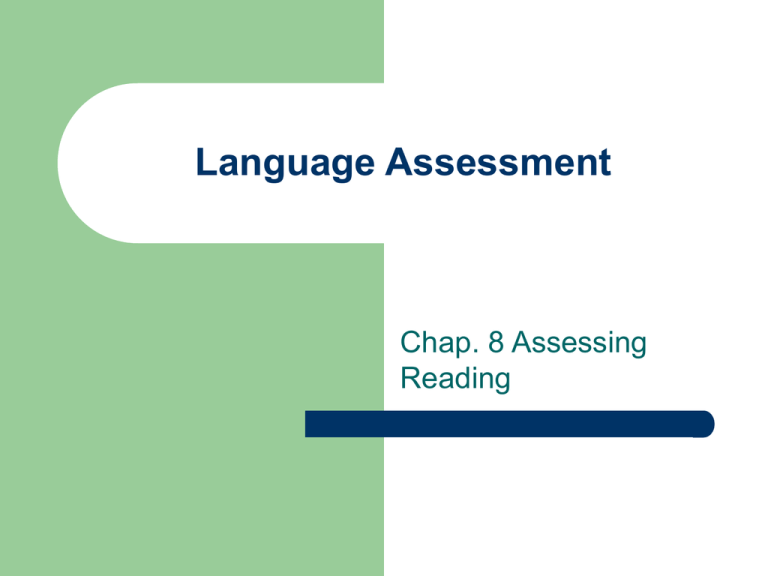
Language Assessment Chap. 8 Assessing Reading Introduction To become efficient readers, two fundamental strategies are needed. They are: (1) bottom-up strategies– processing separate letters, words, and phrases, and (2) top-down strategies– conceptually driven strategies for comprehension. Besides, appropriate content and formal schemata—background information & cultural experience– to carry out interpretations effectively. Types of Reading 1. Academic reading: general articles, technical reports, dictionaries, textbooks, editorials, opinion writings, and so on. 2. Job-related reading: phone messages, letters, schedules, signs, applications, questionnaires, manuals, and so on. 3. Personal reading: newspapers, magazines, notes, recipes, advertisements, cartoons, etc. Types of Reading Performance 1. 2. Perceptive: The tasks involve attending to the components of discourse: letters, words, punctuation, and other graphemic symbols. Bottom-up processing is implied. Selective: Tasks include picture-cued tasks, matching, true/false, multiple-choice, etc. Stimuli are sentences, brief paragraphs, and simple charts and graphs. Brief responses are intended. Both bottom-up & top-down processing may be used. Continue 3. Interactive: Included tasks are stretches of language of several paragraphs to one page or more in which the reader must interact with the text. Typical genres are anecdotes, short narratives, descriptions, announcements, directions, recipes, and the like. Top-down processing is typical of such tasks although bottom-up performance may be necessary. 4. Extensive: Extensive reading includes professional articles, essays, technical reports, short stories, and books. Top-down processing is assumed for most tasks. Perceptive Reading Tasks are fundamental and basic, which are often referred to as literacy tasks, such as recognition of alphabetic symbols, capitalized and lowercase letters, punctuation,and words. Reading Aloud The test-taker sees separate letters, words, and/or short sentences and reads them in the presence of an administrator. Written Response The test-taker’s task is to produce the probe in writing. Multiple-Choice Formats include same/different, circle the answer, true/false, choose the letter, and matching. Picture-Cued Items (P. 192-193) Selective Reading Multiple-Choice: the most popular method of testing a reading knowledge of vocabulary and grammar is the multiple-choice format. (p. 194-195) Advantages: easy to administer & quick to be scored. Matching Tasks: the test-taker responds to the matching format. Typical formats: vocabulary matching task & selected response fill-in vocabulary task (p. 197). Editing Tasks: Editing for grammatical/rhetorical errors is widely used test method for assessing linguistic competence in reading. Example: There are two way of making a A B gas condense: cooling it or putting it C D under pressure. Pictured-Cued tasks: the complexity of the language is more varied in this section than the previous one. Gap-Filling Tasks: Test-takers read a part of a sentence and then complete it by writing a phrase. Example: Oscar: Doctor, what should I do if I get sick? Doctor: It is best to stay home and __________. If you have a fever, _________. You should drink as much ______. The worst thing you can do is _______. You should also Disadvantages: (1) requiring both reading & writing performance.(2) scoring a variety of creative responses. Interactive Reading At this level, tasks have a combination of form-focused and meaning-focused objectives but with more emphasis on meaning. Texts are from a paragraph to a as much as a page. Charts, graphs, and other graphics may be complex in their format. Cloze Tasks: The readers need to fill in gaps in an incomplete image and supply omitted details by using formal schemata, content schemata, and strategic competence. Typically every seventh word is deleted (fixed-ratio deletion), but many cloze test designers use a rational deletion procedure according to the grammatical/discourse functions. Two approaches to the scoring: (1) the exact word method (2) the appropriate word scoring. Fixed-ratio deletion (every seventh word) The recognition that one’s feelings of (1)____ and unhappiness can coexist much like (2)____ and hate in a close relationship (3) offer valuable clues on how to (4)____ a happier life. Rational deletion (prepositions and conjunctions) The recognition that one’s feelings (1)____happiness (2) ____ unhappiness can coexist much like love and hate (3) ____ a close relationship may offer valuable clues (4) ____ how to lead a happier life. Comparisons: the second version allows the test taker to tap into predictions of prepositions and conjunctions in particular. It also provides more washback as students focus on targeted grammatical features. Variations on standard cloze testing: C-test & cloze-elide procedure. C-test procedure: The recognition th_ _ one’s feel _ _ _ _ of happ_ _ _ _ _ _ can coe_ _ _ _ much li_ _ love a _ _ hate I_ a cl_ _ _ relati _ _ _ _ _ _ may of _ _ _ valuble cl_ _ _ on h_ _ to le_ _ a hap_ _ _ _ life. In the above example, the second half of every other word is obliterated and the test taker must restore each word. Cloze-elide procedure: The recognition that one’s now feelings of happiness and unhappiness can under coexist much like love and hate in a close then relationship may offer valuable clues on how to lead a happier with life. The cloze-elide procedure inserts words into a text that don’t belong. The test-taker’s task is to detect and cross out the intrusive words. Impromptu Reading Plus Comprehension Questions (p. 205) It includes a typical reading comprehension passage and a set of questions. Question features: main idea (topic)/expressions, idioms,or phrases in context/inference (implied idea)/grammatical features/detail/supporting ideas/vocabulary in context Short-Answer Tasks: A reading passage is presented, and the test-taker reads questions that must be answered in a sentence or two. Example: In a passage on the future of airline travel. 1. What do you think the main idea of this passage is? 2. What would you infer from the passage about the future of air travel? Editing (Longer Texts) Contextualized grammar editing tasks (1) Ever since supermarkets first appeared, A B they have been take over the world. (2) C D Supermarkets have changed people’s life A styles, yet and at the same time, changes in people’s B C life styles have encouraged the opening of supermarkets. D Scanning Scanning is a strategy used by all readers to find relevant information in a text. Assessment of scanning is carried out by presenting test-takers with a text and requiring rapid identification of relevant bits of information. Possible stimuli include An essay/a menu/an application form/a technical report/ a news article The test-taker must locate the setting for a story the cost of an item on a menu specified data needed to fill out the principal research finding a data, name, or place in an article Ordering Tasks “stripe story” technique Sentence-ordering task: put the sentences in the correct order Information Transfer: Reading Charts, Maps, Graphs, Diagrams Learners must be able to (p. 211) Comprehend specific conventions of the various types of graphics Comprehend labels, headings, numbers, and symbols Comprehend the possible relationships among elements of the graphic; and Make inferences that are not presented overtly Extensive Reading Journal articles, technical reports, longer essays, short stories, and books fall into this category. Skimming Tasks Skimming is the process of rapid coverage of reading matter to determine its gist or main idea. The test-taker skims a text and answers questions such as the following: What is the main idea of the text? What is the author’s purpose in writing the text? What kind of writing is this (newspaper article, manual, novel, etc.)? What do you think you will learn from the text? How useful will the text be for your (profession, academic needs, interests)? Summarizing and Responding Directions for summarizing Write a summary of the text. Your summary should be about one paragraph in length (100-150 words) and should include your understanding of the main idea and supporting ideas. Criteria for assessing a summary 1. Expresses accurately the main idea and supporting ideas. 2. Is logically organized. 3. is written in the student’s own words; occasional vocabulary from the original text is acceptable. 4. displays facility in the use of language to clearly express ideas in the text. Directions for responding to reading In the article “Poisoning the Air We Breathe,” the author suggests that a global dependence on fossil fuels will eventually make air in large cities toxic. Write an essay in which you agree or disagree with the author’s thesis. Support your opinion with information from the article and from your experience. Holistic scoring scale for S & R 3 clear, unambiguous comprehension of the main and supporting ideas. 2 comprehension of the main idea but no supporting ideas. 1 only a partial comprehension of the main and supporting ideas. 0 no comprehension of the main and supporting ideas. Note-Taking and Outlining A teacher, in one-one-one conferences with students, can use student notes/outlines as indicators of the presence or absence of effective reading strategies, and thereby point the learners in positive directions.

